Clyde cod spawning closures
Areas of the Firth of Clyde closed for all fishing between 14 February and 30 April in 2022 and 2023, to protect cod during their spawning season.
Clyde cod spawning closures
Background
- A seasonal spawning closure in the Firth of Clyde has been in place for 20 years to provide an area to protect cod during their spawning season (14th February – 30th April).
- Since its introduction in 2001, the closure has included exemptions to allow Nephrops trawlers, creelers and scallop dredgers to continue to fish in the area, due to the low numbers of cod they catch.
- The closure has been implemented through a Scottish Statutory Instrument, latterly on a biennial cycle.
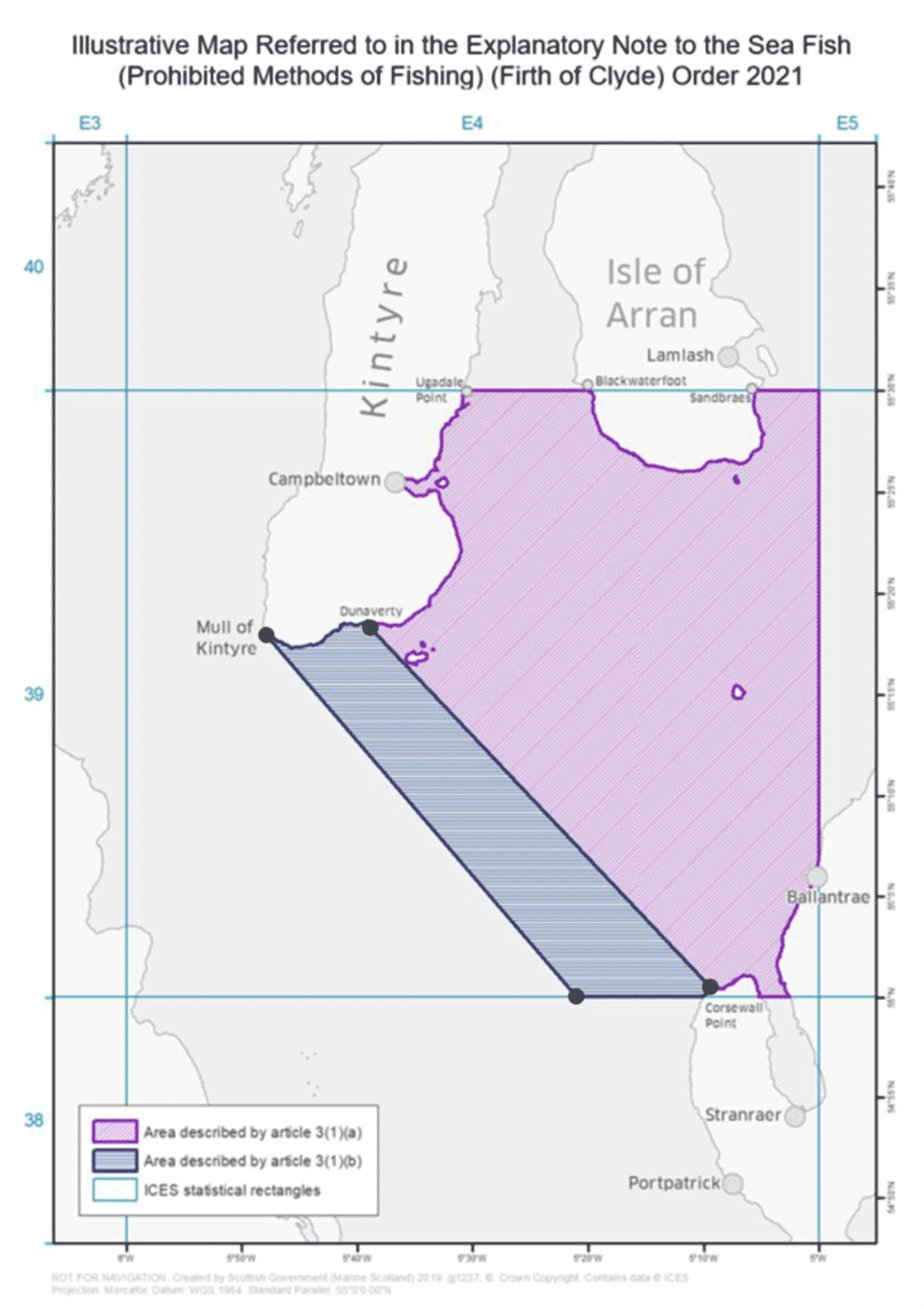
Policy change: underlying principles
- Despite the ongoing seasonal closure, the stock has shown little sign of recovery
- The Scottish Government has therefore decided to maximise the benefits of the closure by making it more targeted and focused
- This decision is in line with both the Future Fisheries Management strategy and the Bute House Agreement, which commit the government to restoring marine habitats in Scottish inshore waters
- It is based on the best available science on cod spawning and aligns to management measures in other areas
- This decision also takes into account the Scottish Government's commitment to consider the precautionary principle in environmental matters
Spawning biology of Atlantic cod
- Cod mate using a "lekking" system
- Males will take possession of seabed areas, protect these against other males, and attract females by "grunting"
- Males may also follow females through the water column up to 10 metres off the seabed while mating
Potential impact of fishing
- Cod are focussed on mating at this time and very vulnerable to fishing
- If disturbed, they are unlikely to return and may not mate that year
- Any fishing within 10 metres of the seabed may cause disturbance; therefore any spawning closure should apply to all gears that approach within 10 metres of the seabed.
- Removal of the exemptions will also create consistency with management in other areas, including the UK National North Sea Cod Avoidance Plan, which covers closure areas for all gear types (excluding pelagic), and the recent emergency Marine Protected Area (MPA) designation in the Inner Sound and related Marine Conservation Order, which includes prohibition on creeling in order to protect the critically endangered flapper skate nursery area.
- This report provides more detail: Cod spawning areas: research
References:
- González-Irusta, J. M. and Wright, P. J. (2016). Spawning ground of Atlantic cod (Gadus morhua) in the North Sea. ICES Journal of Marine Science, 73(2), 304-315.
- Grabowski, T. B, Thorsteinsson, V. and Marteinsdóttir, G. (2009). Assessing the lekking hypothesis for the mating system of Atlantic cod (Gadus morhua) using electronic data-storage tags. ICES CM 2009/B:01.
- Nordeide, J. T. and Folstad, I. (2000). Is cod lekking or a promiscuous group spawner? Fish and Fisheries, 1, 90-93.
- Slabbekoorn, H., Bouten, N., van Opzeeland, I., Coers, A., ten Cate, C. and Popper, A. N. (2010). A noisy spring: the impact of globally rising underwater sound levels on fish. Trends in Ecology and Evolution, 25, 419-427.
Cod spawning: preferred sediment types
- Cod prefer to spawn on harder substrate (coarse sand, gravel)
- But may also spawn on softer ground (sand, muddy sand, sandy mud)
- The least preferred sediment type is fine mud, but spawning right next to muddy areas has been observed
- Any closure should therefore cover at least the sand and gravel areas, but with a precautionary buffer to ensure that spawning is not affected by nearby fishing activity
References:
- González-Irusta, J. M. and Wright, P. J. (2016). Spawning ground of Atlantic cod (Gadus morhua) in the North Sea. ICES Journal of Marine Science, 73(2), 304-315.
- Grabowski, T. B, Thorsteinsson, V. and Marteinsdóttir, G. (2009). Assessing the lekking hypothesis for the mating system of Atlantic cod (Gadus morhua) using electronic data-storage tags. ICES CM 2009/B:01.
- Nordeide, J. T. and Folstad, I. (2000). Is cod lekking or a promiscuous group spawner? Fish and Fisheries, 1, 90-93.
- Slabbekoorn, H., Bouten, N., van Opzeeland, I., Coers, A., ten Cate, C. and Popper, A. N. (2010). A noisy spring: the impact of globally rising underwater sound levels on fish. Trends in Ecology and Evolution, 25, 419-427.
Clyde sediment distribution (1)
The following shows sediment distribution in the relevant area of the Clyde:
- Dark lines = existing closure
- Brown = fine mud
- Lighter brown = muddy sand / sandy mud
- Yellow = sand
- Orange with dots = coarse sediment
- Orange with hatched lines = mixed sediment
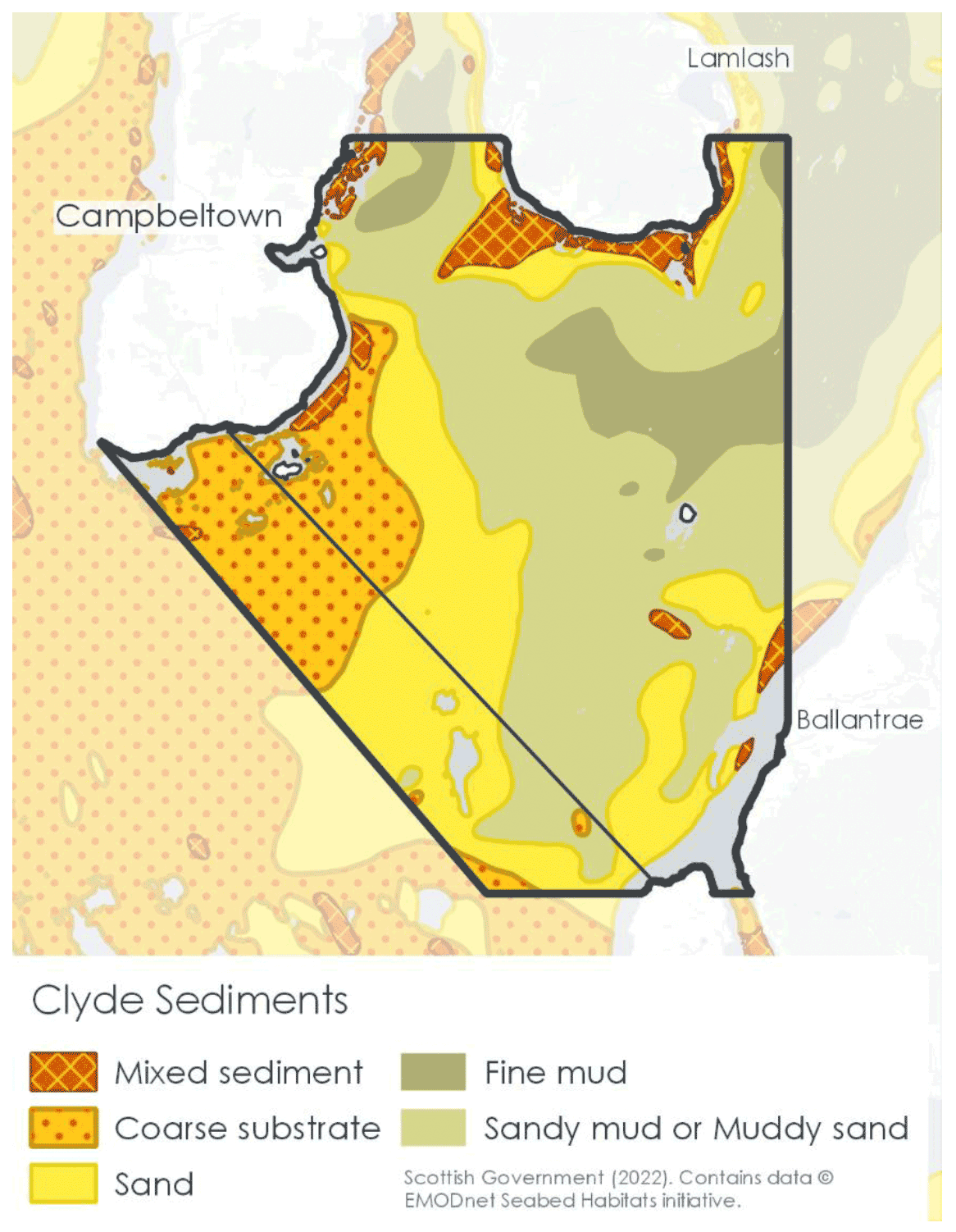
Clyde sediment distribution (2)
- This plot shows:
- Closed area (outline)
- Possible Nephrops habitat: mud and muddy sand / sandy mud (browns)
- Mud and muddy sand / sandy mud covers 48% of overall closed area*
- The area outside Nephrops habitat is the minimum plausible closure, as it only covers the most likely spawning habitat (sand and gravel) with no buffer
*or 61% of the previous Article 3(a) area only
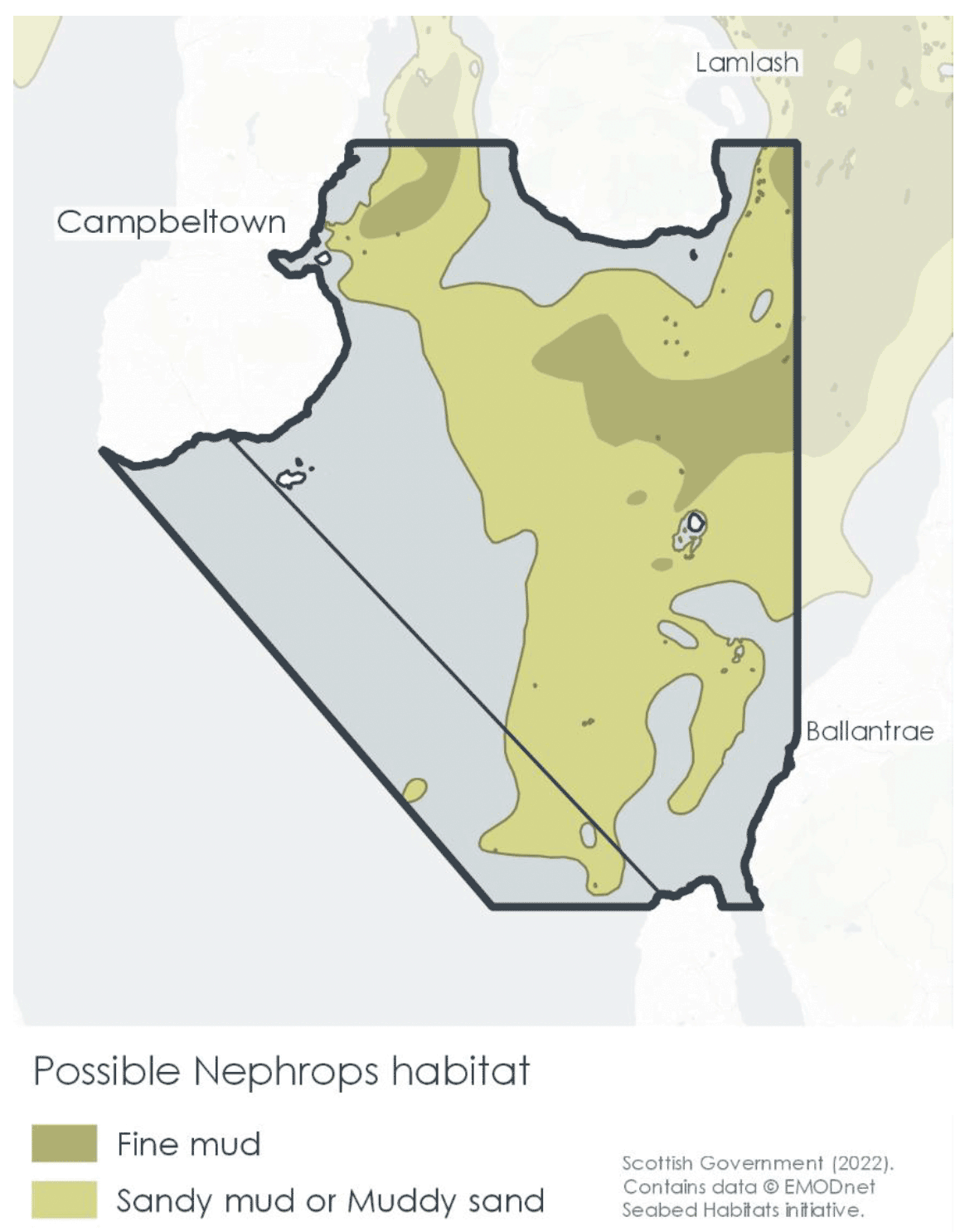
Clyde cod spawning closure
- This plot shows:
- Closed area (outline
- Fine mud (brown)
- Fine mud covers 8.7% of overall closed area*
- The area outside the fine mud is the maximum plausible closure, as cod will not spawn on fine mud (although they may spawn nearby)
*or 11% of the previous Article 3(a) area only
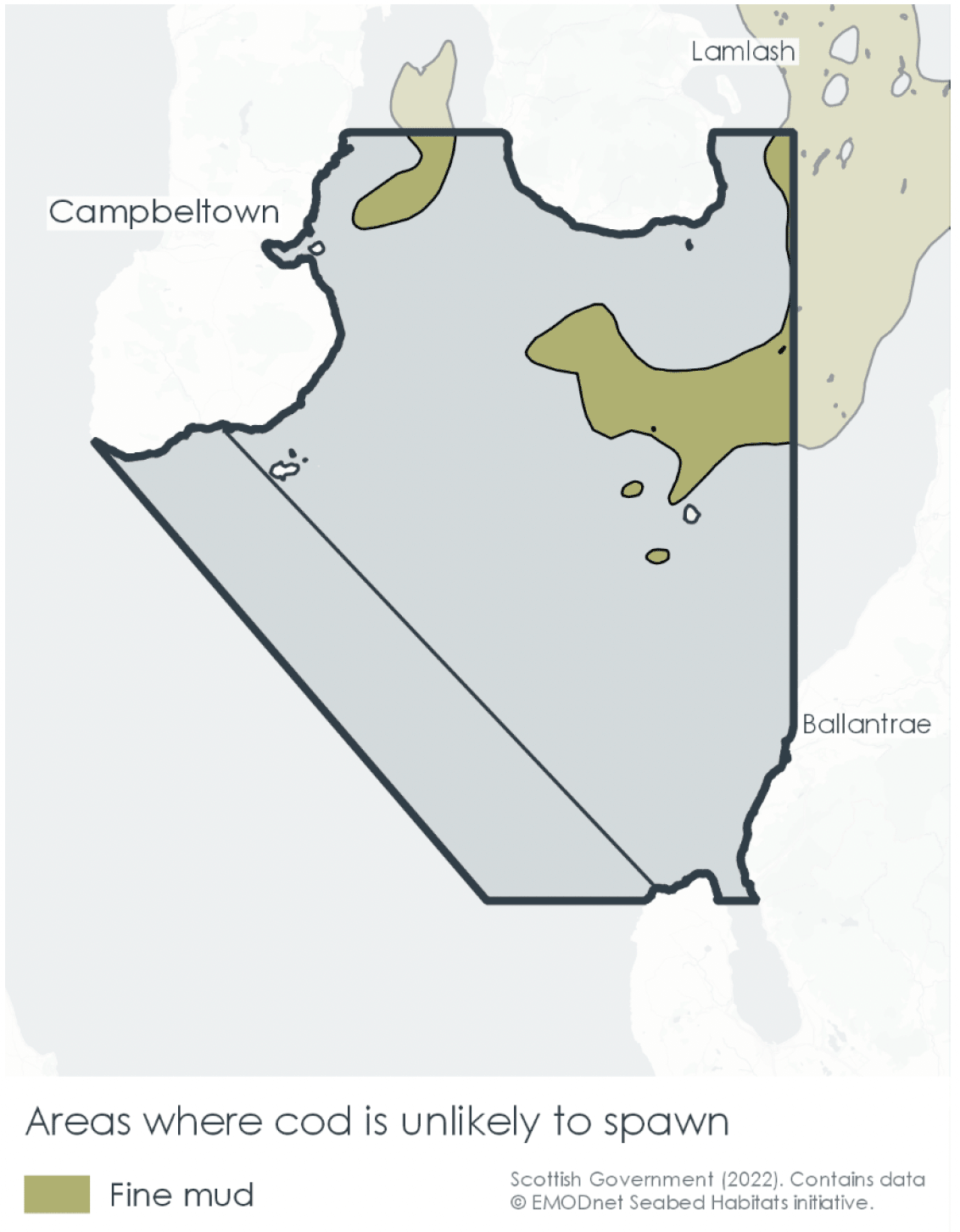
Clyde Cod Closure for 2022 – 23
- The Scottish Government will therefore close the following areas of the Firth of Clyde to all fishing activity between 14th February – 30th April in 2022 and 2023
- This closure covers all non-muddy areas and provides a precautionary buffer between the mud and likely cod spawning habitats
- This is a targeted and proportionate measure, which will reduce the overall size of the closure compared to previous years by 28% overall*, while providing increased protection in cod spawning areas due to removals of exemptions.
- *or 35% of the previous Article 3(a) area only
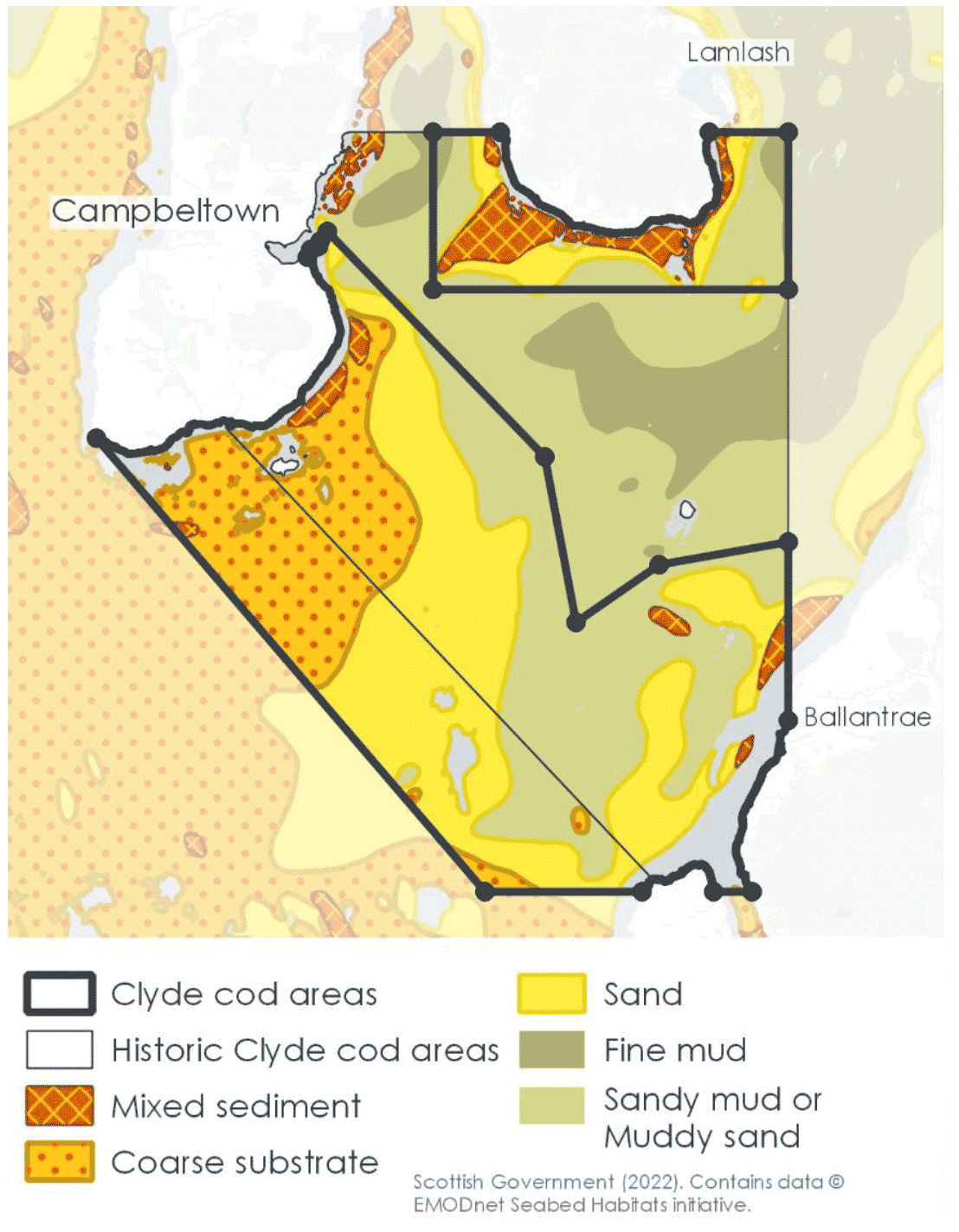
Next steps
- The spawning cod closures are implemented through a statutory instrument. The Scottish Statutory Instrument with the proposed closures comes into effect on 12 February 2022 and the closure begins on 14 February 2022.
- The Scottish Government will continue to actively monitor this closure and to engage with stakeholders on its relevance and effectiveness.
- During the closure we will increase monitoring of activity and catches to assess in particular whether, and where cod are being caught outside the closure area, and whether they were mature enough to spawn.
- We intend to hold a meeting with stakeholders at the end of the 2022 closure to reflect on the effectiveness of the revised closure area.
Contact
Email: Kerrie.Campbell@gov.scot
There is a problem
Thanks for your feedback